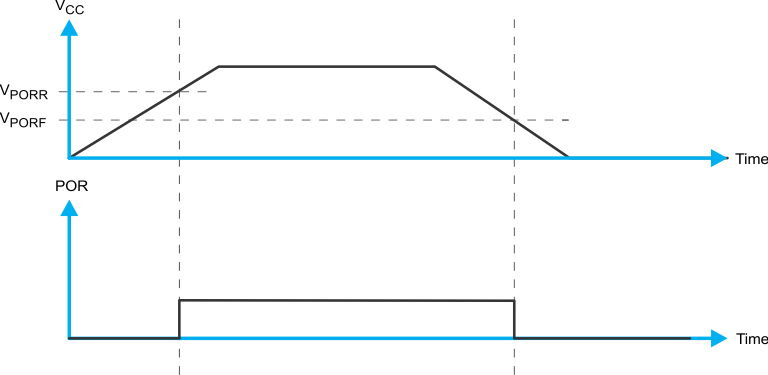JAJSI81B April 2014 – November 2019 TCA9546A
PRODUCTION DATA.
- 1 特長
- 2 アプリケーション
- 3 概要
- 4 改訂履歴
- 5 概要(続き)
- 6 Pin Configuration and Functions
- 7 Specifications
- 8 Parameter Measurement Information
- 9 Detailed Description
- 10Application and Implementation
- 11Power Supply Recommendations
- 12Layout
- 13デバイスおよびドキュメントのサポート
- 14メカニカル、パッケージ、および注文情報
パッケージ・オプション
メカニカル・データ(パッケージ|ピン)
サーマルパッド・メカニカル・データ
発注情報
11.1 Power-On Reset Requirements
In the event of a glitch or data corruption, TCA9546A can be reset to its default conditions by using the power-on reset feature. Power-on reset requires that the device go through a power cycle to be completely reset. This reset also happens when the device is powered on for the first time in an application.
A power-on reset is shown in Figure 19.
 Figure 19. VCC is Lowered Below the POR Threshold, Then Ramped Back Up to VCC
Figure 19. VCC is Lowered Below the POR Threshold, Then Ramped Back Up to VCC Table 2 specifies the performance of the power-on reset feature for TCA9546A for both types of power-on reset.
Table 2. Recommended Supply Sequencing And Ramp Rates(1)
| PARAMETER | MIN | TYP | MAX | UNIT | ||
|---|---|---|---|---|---|---|
| VCC_FT | Fall time | See Figure 19 | 1 | 100 | ms | |
| VCC_RT | Rise time | See Figure 19 | 0.1 | 100 | ms | |
| VCC_TRR | Time to re-ramp (when VCC drops below VPORF(min) – 50 mV or when VCC drops to GND) | See Figure 19 | 40 | μs | ||
| VCC_GH | Level that VCC can glitch down to, but not cause a functional disruption when VCC_GW = 1 μs | See Figure 20 | 1.2 | V | ||
| VCC_GW | Glitch width that will not cause a functional disruption when VCC_GH = 0.5 × VCC | See Figure 20 | 10 | μs | ||
| VPORF | Voltage trip point of POR on falling VCC | See Figure 21 | 0.8 | 1.25 | V | |
| VPORR | Voltage trip point of POR on rising VCC | See Figure 21 | 1.05 | 1.5 | V | |
Glitches in the power supply can also affect the power-on reset performance of this device. The glitch width (VCC_GW) and height (VCC_GH) are dependent on each other. The bypass capacitance, source impedance, and device impedance are factors that affect power-on reset performance. Figure 20 and Table 2 provide more information on how to measure these specifications.
 Figure 20. Glitch Width and Glitch Height
Figure 20. Glitch Width and Glitch Height VPOR is critical to the power-on reset. VPOR is the voltage level at which the reset condition is released and all the registers and the I2C/SMBus state machine are initialized to their default states. The value of VPOR differs based on the VCC being lowered to or from 0. Figure 21 and Table 2 provide more details on this specification.
 Figure 21. VPOR
Figure 21. VPOR